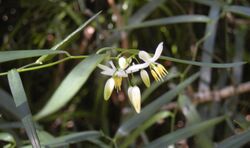Biology:Geitonoplesium
| Geitonoplesium | |
|---|---|

| |
| Flowers | |

| |
| Fruit, at Paruna Reserve, Como, Sydney, NSW. | |
Script error: No such module "Conservation status".
| |
| Scientific classification | |
| Kingdom: | Plantae |
| Clade: | Tracheophytes |
| Clade: | Angiosperms |
| Clade: | Monocots |
| Order: | Asparagales |
| Family: | Asphodelaceae |
| Subfamily: | Hemerocallidoideae |
| Genus: | Geitonoplesium A.Cunn. ex R.Br.[2][1] |
| Species: | G. cymosum
|
| Binomial name | |
| Geitonoplesium cymosum (R.Br.) A.Cunn. ex R.Br.[1]
| |
| Synonyms[3] | |
| |
Geitonoplesium is a monotypic genus in the family Asphodelaceae, containing the sole species Geitonoplesium cymosum, commonly known as scrambling lily.[4][5] The species is a perennial evergreen scrambling vine found in rainforests, sclerophyll forests and woodlands of eastern Australia ,[4] and parts of Malesia and Melanesia.[1][5][6]
The leaves are variable, usually narrow-lanceolate to linear, 2–10 cm (0.8–3.9 in) long and 3–25 mm (0.1–1.0 in) wide. Both surfaces of the leaves are glossy, with the midvein prominent and raised on the upper surface. The flowers are mauve to white. The globular berries are 5–11 mm (0.2–0.4 in) in diameter and contain one or two more or less globular black seeds.[4][5] There is a high degree of variation in the shape of the leaves, which has resulted in the establishment of numerous infraspecific taxa over the years. However, none of these are recognised by leading present-day authorities.[7]
Uses
The shoots are edible when boiled, and comparable to asparagus.[8][9]
References
- ↑ 1.0 1.1 1.2 "Geitonoplesium cymosum". Royal Botanic Gardens, Kew. http://powo.science.kew.org/taxon/urn:lsid:ipni.org:names:535911-1.
- ↑ "Geitonoplesium cymosum". Centre for Plant Biodiversity Research, Australian Government. https://id.biodiversity.org.au/name/apni/101727.
- ↑ "Geitonoplesium cymosum (R.Br.) A.Cunn. ex R.Br.". World Checklist of Selected Plant Families (WCSP). Royal Botanic Gardens (Kew). http://www.theplantlist.org/tpl1.1/record/kew-307862. Retrieved 5 Mar 2016.
- ↑ 4.0 4.1 4.2 F.A. Zich; B.Hyland. "Geitonoplesium cymosum". Centre for Plant Biodiversity Research, Australian Government. https://apps.lucidcentral.org/rainforest/text/entities/Geitonoplesium_cymosum.htm.
- ↑ 5.0 5.1 5.2 "PlantNET - FloraOnline". Royal Botanic Gardens and Domain Trust, Sydney. https://plantnet.rbgsyd.nsw.gov.au/cgi-bin/NSWfl.pl?page=nswfl&lvl=sp&name=Geitonoplesium~cymosum.
- ↑ Conran, J.G.; Clifford, H.T. (2020). "Geitonoplesium cymosum". Australian Biological Resources Study, Department of Agriculture, Water and the Environment: Canberra. https://profiles.ala.org.au/opus/foa/profile/Geitonoplesium%20cymosum.
- ↑ Laferrière, Joseph E. (1995). "Nomenclature and type specimens in Eustrephus R.Br. and Geitonoplesium Hook. (Geitonoplesiaceae)". Austrobaileya 4 (3): 391–399.
- ↑ Low, Tim (1991). Wild food plants of Australia (revised ed.). North Ryde, N.S.W.: Angus & Robertson. p. 122. ISBN 9780207169304.
- ↑ "Geitonoplesium cymosum - (R.Br.)A.Cunn.". https://pfaf.org/user/Plant.aspx?LatinName=Geitonoplesium+cymosum.
<ref> tag with name "DESQLD" defined in <references> is not used in prior text.
Wikidata ☰ Q5556362 entry
 |

